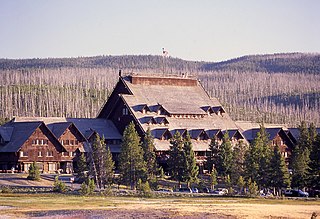
The Old Faithful Inn is a hotel in the western United States with a view of the Old Faithful Geyser, located in Yellowstone National Park, Wyoming. The Inn has a multi-story log lobby, flanked by long frame wings containing guest rooms. In the western portion of the park, it sits at an approximate elevation of 7,350 feet (2,240 m) above sea level.

The Arizona Biltmore is a historic resort located in Phoenix near 24th Street and Camelback Road. Designed by Albert Chase McArthur, it opened on February 23, 1929, as part of the Biltmore Hotel chain. Actors Clark Gable and Carole Lombard often stayed there and the Tequila sunrise cocktail was invented there. It is part of LXR Hotels & Resorts.

The Fairmont Banff Springs, formerly and commonly known as the Banff Springs Hotel, is a historic hotel in western Canada, located in Banff, Alberta. The entire town, including the hotel, is situated in Banff National Park, a national park managed by Parks Canada. At an elevation of 1,414 metres (4,640 ft) above sea level, the hotel overlooks a valley towards Mount Rundle, both of which are situated within the Rocky Mountain mountain range.
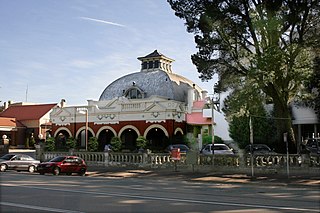
The Hydro Majestic Hotel is located in Medlow Bath, New South Wales, Australia. The hotel is located on a clifftop overlooking the Megalong Valley on the western side of the Great Western Highway.

The Fairmont Hotel Macdonald, formerly and commonly known as the Hotel Macdonald, is a large historic luxury hotel in Edmonton, Alberta, Canada. Located along 100 Street NW, south of Jasper Avenue, the hotel is situated in the eastern end of downtown Edmonton, and overlooks the North Saskatchewan River. The 47.7-metre-high (156 ft) hotel building was designed by Ross and MacFarlene and contains eleven floors. The hotel is named for the first prime minister of Canada, Sir John A. Macdonald.

The Fairmont Empress, formerly and commonly referred to as The Empress, is one of the oldest hotels in Victoria, British Columbia, Canada. Located on 721 Government Street, it is situated in Downtown Victoria, facing the city's Inner Harbour. The hotel was designed by Francis Rattenbury, and was built by Canadian Pacific Hotels, a division of the Canadian Pacific Railway company. The hotel is presently managed by Fairmont Hotels and Resorts, part of AccorHotels since 2016. It is owned by Nat and Flora Bosa of Vancouver.

The Birkdale Palace Hotel was a luxury hotel located in the Lancashire coastal resort of Birkdale, Southport, on the north-west coast of England. The building towered over the surrounding area for over a hundred years before being demolished in 1969. During the Second World War it had been used as a rehabilitation centre for US airmen, and in the last two years of existence was used as a film location. The Palace is notorious in local folklore as a haunted hotel.
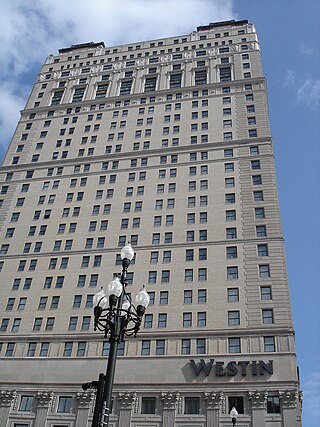
The Westin Book Cadillac Detroit is an historic skyscraper hotel in downtown Detroit, Michigan, within the Washington Boulevard Historic District. Designed in the Neo-Renaissance style, and opened as the Book-Cadillac Hotel in 1924, the 349 ft (106 m), 31-story, 453-room hotel includes 65 exclusive luxury condominiums and penthouses on the top eight floors. It reopened in October 2008, managed by Westin Hotels, after a $200-million restoration.

Hot Lake Hotel is a historic Colonial Revival hotel originally built in 1864 in Hot Lake, Union County, Oregon, United States. The hotel received its namesake from the thermal spring lakes on the property, and operated as a luxury resort and sanitorium during the turn of the century, advertising the medicinal attributes of the mineral water and drawing visitors worldwide. It is also the first known commercial building in the world to utilize geothermal energy as its primary heat source.

The Battle House Renaissance Mobile Hotel & Spa, is a historic hotel in Mobile, Alabama. The current structure was built in 1908 as the Battle House Hotel. It is the second hotel by that name to stand in this location, replacing an earlier Battle House built in 1852, which burned down in 1905. It is one of the earliest steel frame structures in Alabama.
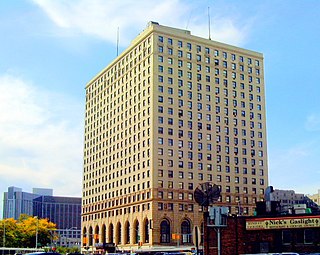
The Detroit-Leland Hotel is a historic hotel located at 400 Bagley Street in Downtown Detroit, Michigan. It is the oldest continuously operating hotel in downtown Detroit, and was listed on the National Register of Historic Places in 2005. The ballroom of the Detroit-Leland has hosted a nightclub, the Leland City Club, since 1983. The hotel is now named The Leland and no longer rents to overnight guests.

The ITC Grand Chola is a 5-star luxury hotel in Chennai, India. It is located in Guindy, opposite SPIC building and along the same row of buildings as Ashok Leyland Towers. The building, designed by Singapore-based SRSS Architects, is of mixed-use development with three separate wings and is themed after traditional Dravidian architecture of the Chola dynasty. The hotel is the ninth hotel in The Luxury Collection brand.

The Sans Souci Hotel was a hotel located in Ballston Spa, Saratoga County, New York. It was built in 1803, closed as a hotel in 1849, and the building, used for other purposes, was torn down in 1887.

Crieff Hydro is a hotel in Crieff, Perthshire, Scotland. The purpose-built hotel opened in 1868 as the Crieff Hydropathic Establishment, and is locally known as the Hydro. It was founded in 1868 by Dr Thomas Henry Meikle, who had received treatment at a centre in Gräfenberg, Austria, where Vincenz Priessnitz had built such an establishment. Preissnitz based his pharmacopeia on water, exercise, fresh mountain air, water treatments in the brooks and simple country food.
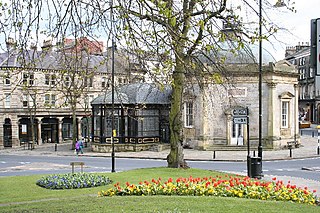
The Royal Pump Room is a Grade II* listed building in Harrogate, North Yorkshire, England. Today it houses the town's museum – operated by North Yorkshire Council. It was formerly a spa water pump house. It is located in Crown Place in the western part of Harrogate town centre, opposite the town's Valley Gardens park. It is bounded by two streets, Crescent Road and Royal Parade. Today, the Pump Room consists of both the original 1842 stone rotunda and a glazed annexe which was opened in 1913. The Pump Room offered guests of the town an all weather facility where they could drink sulphur water which was pumped on site from a natural spring known as the Old Sulphur Well. The building also had a social element to it as it provided guests with a place to meet friends and get to know others.

The Hotel John Marshall, first opened in 1929, was one of the leading hospitality establishments in downtown Richmond, Virginia. After the hotel closed in 2004, the building was renovated into upscale residential apartments that opened in December 2011.

The Briarcliff Lodge was a luxury resort in the village of Briarcliff Manor, New York. It was a notable example of Tudor Revival architecture, and was one of the largest wooden structures in the United States. It was also the first hotel in Westchester County. Walter William Law had it built on his estate, and the Law family owned it until 1937. When the lodge opened in 1902, it was one of the largest resort hotels in the world. The lodge hosted presidents, royalty, and celebrities, and was the scene of numerous memorable occasions for visitors and local residents who attended weddings, receptions, and dances in the ballroom and dining room. For a long time, the lodge was situated among other businesses of Walter Law, including the Briarcliff Farms and Briarcliff Table Water Company.

The County Hall is a municipal building in Matlock, Derbyshire, England. The building, which was originally a hydropathic establishment but is now the headquarters of Derbyshire County Council, is a Grade II listed building.

The Palace Hotel was opened in 1868 in Buxton, Derbyshire, England. It holds a prominent position in the town's central Conservation Area overlooking the town. It is a Grade-II listed building.
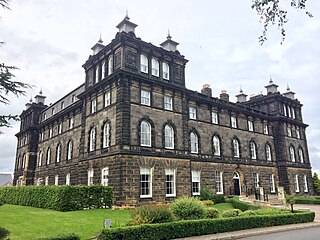
Wells House is a large former hydropathic establishment and hotel in Ilkley, West Yorkshire, England, now used as private apartments. It was built in 1854–56 to a design by the architect Cuthbert Brodrick and is a Grade II listed building. It is located above the town on Wells Road at the edge of Ilkley Moor, giving it an unobstructed view across Wharfedale from its north front. It was originally set in grounds by the landscaper Joshua Major though these gardens have mostly been built on since.






















